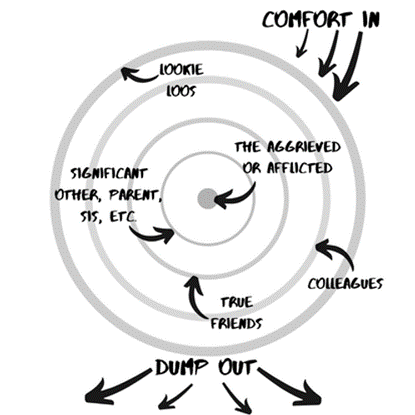
Scouting provides some great life lessons. You learn simple but important life lessons as part of Girl and Boy Scout traditions and training. “Do a good turn daily.” As a young scout, I took an oath, “On my honor… I will do my best to do my duty… To help other people at all times….” For a recent blog I authored about burnout, I ended with a call to action, “Do yourself and the world a favor – ask for help, offer help.” What was missing from that blog and the scouting manuals was a framework for dealing practically and pragmatically with people who are suffering – the aggrieved or afflicted.
Today we face a myriad of challenges that contribute to an alarming increase in depression. Many of the factors are additive, some multiplicative – divisive politics, war, the possibility of a recession, cybersecurity attacks, and pandemic/endemic viruses. People are in pain and hurting. Specifically, how can you help? In April 2013, Susan Silk, a psychologist, and Barry Goldman, an arbitrator and mediator, published an article in the LA Times about Ring Theory. This psychological framework is relatively easy to remember and remarkably effective at helping the aggrieved or afflicted. It was inspired by Silk’s personal experience with breast cancer. It’s a great approach that can help you help others.
Here’s a visual rendering of their theory:

The overall goal suggested by the authors, as shown in the figure, is “Comfort IN, dump OUT.” The rules for approaching and supporting the aggrieved or affected individual in the center are sensible. Borrowing liberally from the authors and others, I have created the following recommendations, which are part of a graduate MBA curriculum I use when teaching leadership and IT in the healthcare enterprise.
“The person in the center ring can say anything she wants to anyone, anywhere.” There should be no limit to how much time they take, the language they use, or when they say it. Your role is active listening. Regardless of your feelings or their appearance, don’t share. Their feelings are what count.
Provide comfort and support to the person in a ring closer to the aggrieved or afflicted. Please note the labels in the figure and the position of the rings. Locate your position on the rings and pay attention to those closer to the center. Instead of fumbling with a lot of words, you can help a person closer to the center with a simple question, as the authors suggest, “What do you need?”
Do NOT complain to anyone in a ring closer to the aggrieved or afflicted. If you are affected adversely by the situation or their appearance, get help from someone in a ring outside of yours. Do not ask for help from someone in the same ring or a ring closer to the center.
Be brief. “I’m sorry” is a complete sentence. When I’ve been at the center, I only wanted to hear, “I’m sorry.”
Avoid comparisons to your own experiences. Sadly, we will all get our turn in the center. Remember, your experiences are based on your social and personal ecosystem, not theirs.
Never say, “I know how you feel.” This is a time when you may empathize but do so silently. You may have similar feelings, but they are bundled in with the totality of your feelings, not theirs.
Follow through. If they ask for your help, provide it. If you cannot, make sure they know it. Don’t add more disappointment to their already difficult situation. Make sure you manage their expectations by letting them know what to expect, when, and how.
We all will spend some time in the center as the aggrieved or afflicted. Please use Ring Theory to help yourself help someone else. When done well, they will appreciate it; you will appreciate it.
